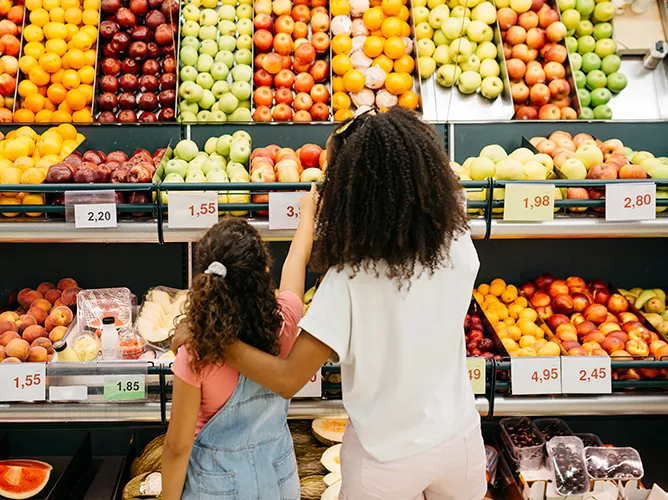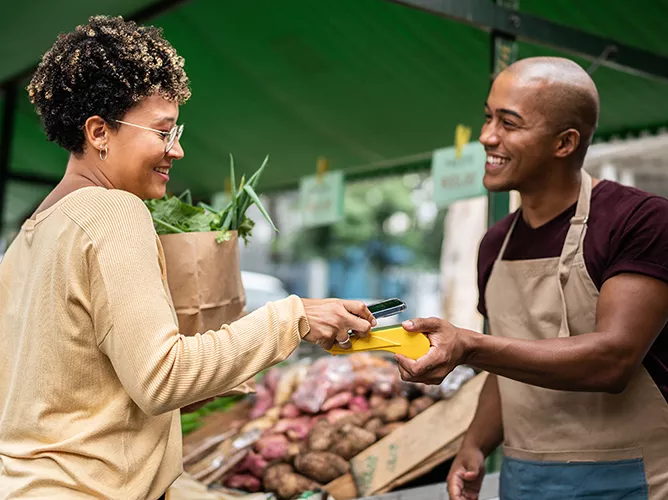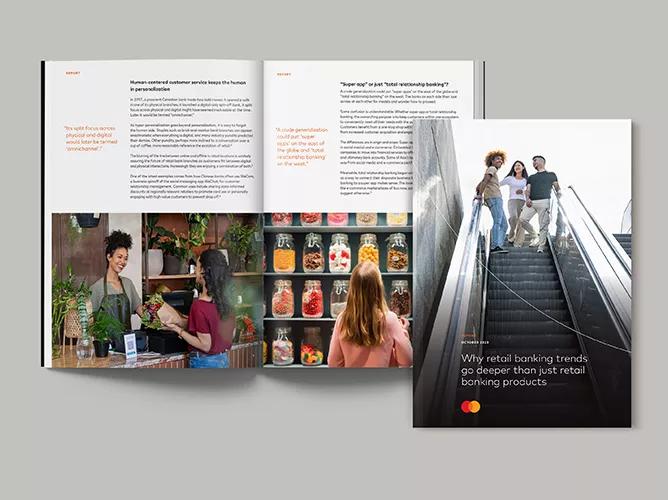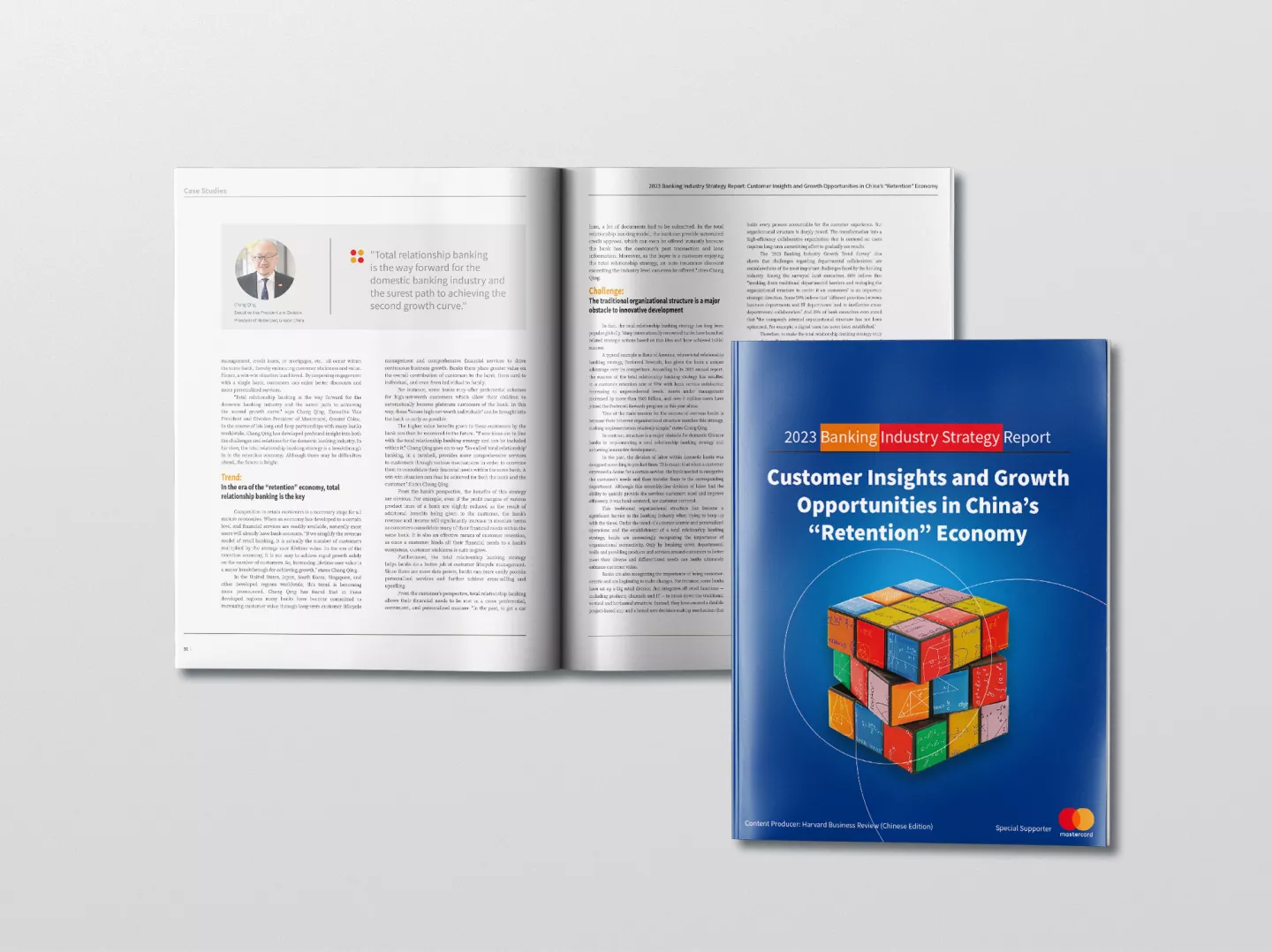By: Emilie Kroner, Sheila Iwano, Andrew Thackray and Evan Voshell
Published: January 12, 2024 | Updated: April 04, 2024
Read time: 15 minutes
- Table of contents
Want a more snackable version of this report? Check out our infographic here.
Introduction
If 2023 was the year of the resilient consumer, 2024 will be the year of the empowered consumer. Despite rising interest rates, inflation and the threat of a recession, consumers still confidently spent money in 2023 thanks to solid job growth and wages.
In 2024, consumers will prioritize resources carefully. People satisfied some of their pent-up demand for experiences built up over the pandemic years, and now spending on experiences and things will edge closer to 2019 levels. Many people worldwide will look for more deals and discounts as they carefully balance their household budgets.
Technology will also play a bigger role in bringing innovation and efficiency to retailers and consumers, from how brands respond to higher consumer expectations to staying competitive among a growing field of retailers. The 2024 retail industry trends reflect a more concerted shift toward a customer-centric and digitally driven retail landscape.
Global economic outlook for retail
The retail industry has faced headwinds and tailwinds in the last three years, many of which are owed to an unusual economic cycle.
In 2024, the economy may start looking more “normal,” according to the Mastercard Economics Institute. But it’s still an economy that continues to rebalance itself, which means consumers and businesses will prioritize their spending and investments. As the economy continues to rebalance, consumers and businesses will prioritize how they spend and invest.
Here are a few of the economic factors that could impact the retail industry globally in 2024:
- Inflation will ease in most economies around the world.
- As inflation cools more than wage inflation, consumer purchasing power should increase.
- Consumer spending on experiences and things may track more similarly than in the past few years, particularly in real terms.
As the economy continues to rebalance, consumers and businesses will prioritize how they spend and invest.
What to expect in North America
According to the Mastercard Economics Institute, easing inflation means American consumers can maintain their strong purchasing power and continue spending in 2024, with stronger “real” spending. In nominal terms, spending growth will likely slow compared to the previous three years.
In 2023, consumers fulfilled their “needs” for food and “wants” for concerts and movies. However, “impulse” spending, which is less intentional and considered an “add-on” to a shopping trip, struggled. The Mastercard Economics Institute expects less basket bifurcation in 2024 between things and experiences, particularly in real terms, although impulse purchases could be deprioritized.
US retailers will likely continue to focus on gaining market share, retaining customer loyalty and competing against smaller, more innovative brands.
In Canada, expect continued labor market growth to support spending. However, Canadian consumers have been dealing with higher debt burdens, reflecting elevated debt levels and mortgage rates increases. It has become harder to service debt, which reduces the ability to spend elsewhere.
What to expect in Latin America
Solid labor markets in Latin America will prompt consumers to continue spending in 2024, although at a slower pace than in 2023.
Resilient consumers, particularly in Brazil and Mexico, made 2023 a better-than-expected year for the Latin American retail industry. In 2024, the industry could benefit from additional disposable income – interest rates are expected to decline and debt consolidation will continue making progress. Food inflation could also fall, freeing more space in consumers’ wallets.
Latin American retailers will focus on aligning their strategies with the ongoing decline in interest rates, debt consolidation efforts and stronger consumer purchasing power.
What to expect in Europe
Europeans will have stronger purchasing power in 2024, driven by wage growth outpacing inflation. However, there may be significant differences in how certain shoppers spend.
Due to shorter mortgage fixings in Europe, high interest rates impact many mortgage holders who tend to be in middle to higher-income households. Affluent consumers, who were less impacted by inflation and maintained their discretionary spending in 2023, may now scale back in that area.
Less affluent shoppers will feel more of an impact from disinflation and spend more than the previous year on discretionary items. Greater disinflation in goods than in services may also narrow the disparity in spending on experiences vs. things, particularly in “real” terms.
European retailers will focus on adapting their strategies to cater to the diverse needs of consumer segments.
What to expect in the Middle East and North Africa
Consumers spent very differently in 2023 based on whether they were in oil-producing countries or oil-importing countries.
The retail sector has experienced broad-based growth in Gulf countries supported by a pro-cyclical fiscal policy that has fueled the non-oil economy, employment and consumption. The domestic economy of the United Arab Emirates (UAE) received an additional boost from an influx of expats that is now moderating.
Consumer spending was weaker in oil-importing countries like Egypt, Lebanon and Jordan, due to currency pressures and high inflation, especially for essentials. Retail spending should pick up near the second half of 2024 after some policy adjustments and resulting job generation and investments.
Tourism will continue to dominate in the region as Gulf countries, particularly Saudi Arabia and the UAE, continue to diversify their economies away from oil. Luxury retail will also continue to thrive as affluent consumers in the region continue to spend.
Retailers in the Gulf could fare well in 2024, largely because of a robust labor market and tourism. This part of the region also has a large population of affluent, big spenders; luxury retail will continue doing well despite slowdowns in other parts of the world.
What to expect in Asia Pacific
Tight labor markets and a catch-up of inflation-adjusted wages should keep consumer spending in Asia Pacific resilient in 2024.
In 2022 and 2023, consumers in Asia Pacific fulfilled their pent-up demand to get out and about.
In 2024, increasing fulfillment of pent-up demand will see consumers in the region recalibrate their budgets.
In such a diverse and complex economy, consumers in many Asia Pacific countries will reprioritize their spending in different ways across travel, discretionary goods and essentials.
Economies in ASEAN and Oceania, which will enter their third year without pandemic restrictions, could rotate from fulfilling out-and-about demand to goods. India has remained relatively resilient thanks to domestic demand, and there could be more of the same spending in 2024 on travel, tourism and retail therapy.
Meanwhile, Northeast Asian economies, which reopened in late 2022 or early 2023, may continue to see out-and-about services outperform for a good part of 2024.
As consumers in the region increase their spending on goods, they will also look for the right deals and take advantage of big sales days. Retailers should find the right pricing and promotion structures that resonate with shoppers.
Understanding and reaching consumers
- Retailers will focus on connecting with the “empowered consumer.”
- Personalization tactics will shift from purely transactional to deeply empathetic.
A better understanding of the consumer leads to a better connection in almost every relationship – whether that understanding comes with the first interaction or further into the relationship.
Consumers and retailers have been through many changes in the last four years, with retailers seeing massive shifts in what people buy, who they buy it from and how much they’re willing to spend. Consumers will continue evolving their shopping habits in various ways in 2024 after three years of fulfilling their pent-up demand for experiences— from the search for a “good deal” to when and where they choose to buy.
As consumers evolve their habits and preferences, retailers are looking for new ways to understand and connect with their shoppers. Companies are exploring and testing how consumers react to specific promotions and prices while balancing their revenue targets.
Consumers will continue evolving their shopping habits in various ways in 2024 after three years of fulfilling their pent-up demand for experiences— from the search for a “good deal” to when and where they choose to buy.
Furthermore, personalization strategies will continue to expand in retail marketing, with empathy playing a bigger role in approaches and tactics.
The empowered consumer
The “empowered consumer” of 2024 will carefully balance prices and priorities as the economy rebalances. This is forcing a change in when people buy, particularly online.
Remember the days of ordering something online and getting that dreaded notification of shipping delays? These delays required online shoppers to plan ahead and have alternative options.
With global supply chain bottlenecks in the rearview mirror, many consumers will return to waiting longer to make a purchase – online or in-store. More time allows shoppers to search for promotions and the best deals. Many are even going in-store to see and hold a product and then leveraging the same brand’s online presence to make the purchase.
As consumers look for their definition of a “good deal” in 2024, retailers will rely more heavily on testing and analytics to find the right balance between managing the rising cost of goods and providing the kind of promotion that will attract incremental spend and ongoing engagement. Retailers will want to extend offers that foster greater loyalty and share of spending among customers.
With global supply chain bottlenecks in the rearview mirror, many consumers will return to waiting longer to make a purchase – online or in-store.
Brick-and-mortar retailers are becoming even more precise in their offer strategies by testing store-wide promotions in a subset of locations and looking at offers for specific loyalty customers. Retailers are also tapping into consumer spend data to understand where best to allocate their marketing dollars. Retailers will also look at consumer spending patterns and other relevant and available data to decide where to put stores, and how big those stores should be.

Grocer compared its performance against competitors, prioritized markets for customer outreach.
While retailers have tapped into shopper segmentations for some time, the proliferation of available data and the computing power of artificial intelligence can pave the way for a more nuanced understanding of consumers.
Consumers are not necessarily monolithic within a specific shopper segment. For example, some may be value-conscious when shopping for athletic apparel and also willing to pay premium prices for luxury cosmetics brands.
The advancement of sophisticated analytics, powered by the speed of AI, can help establish a more accurate, multi-dimensional representation of the complex nature of an individual shopper to enable impactful personalization.
Empathy-driven personalization
Historically, brands have taken a transaction-focused approach to tailoring the digital experience, using it to provide greater relevance in exchange for improved business metrics. With the advent of more advanced AI and analytics capabilities, personalization continues to evolve into an increasingly sophisticated and critical component in retail customer engagement strategies.
Personalization is shifting beyond merely capturing conversions or engagement to delivering better overall experiences. Personalization journeys are based on a deep understanding and anticipation of customer wants and needs, reflecting the growing consumer demand for greater brand empathy.
Retailers will seek a deeper understanding of the situations, perceptions and expectations that shape a given customer’s daily life to create an empathy-driven experience—one no longer only measured by cost, speed or profitability but instead incorporating engagement and loyalty as an indicator of customer lifetime value.
Personalization journeys are based on a deep understanding and anticipation of customer wants and needs, reflecting the growing consumer demand for greater brand empathy.
Personalization approaches in 2024 will focus on driving relevant experiences for the consumer segments who engage a retail brand. These relevant experiences are continuously improved through robust testing.
For example, a children’s clothing retailer might have a few pre-defined shopping segments, including first-time parents, parents of multiples, and gift-givers like extended family. Each segment’s digital experience should be tailored to their respective shopping intent.
Further, brands should think about connecting online shopping touchpoints with the physical store, especially where it’s commonplace for a customer journey to start online and convert in a physical store. This happens with sales associates who have relevant recommendations and insights via clienteling tablets or similar devices.
This shift from transactional personalization to empathetic personalization based on a deeper understanding of purchase intent will help consumers feel more connected to the brand and the buying experience.
So once a retailer understands and makes a connection with a consumer, how do they turn them into a loyal customer?
Turning shoppers into loyal customers
- Brands will hit “reset” to make their programs less transactional and more experiential.
- Convenience and consistency bridge the gap between digital and physical as brands put equal emphasis on online and in-store interactions.
- Brands will continue to explore paid loyalty as a new revenue stream.
- Gamification enters a new phase and takes a step further in loyalty and engagement.
Shoppers want tailored interactions and to feel real value from the loyalty programs they join in exchange for sharing their personal information and keeping the brand’s app on their phone. With most loyalty programs offering some incentive after spending a certain amount of money, consumers have grown to feel entitled to those perks.
Successful brands will understand that loyalty is more than just a program, channel or single interaction. Instead, loyalty is an outcome of an authentic customer experience. Consumers in 2024 will challenge brands to think about loyalty holistically. Brands will embed their offering into customers’ daily lives by deploying a rule of three: utility, convenience and personalized experiences.
Are utility, convenience and personalization the type of essentials that should resonate with all consumers? Yes. Is there an opportunity for loyalty programs to elevate their engagement approach? Absolutely, because in 2024, consumers will expect more in exchange for their loyalty.
Successful brands will understand that loyalty is more than just a program, channel or single interaction. Instead, loyalty is an outcome of an authentic customer experience.
Brands focus on providing utility beyond points and rewards
The average US consumer is in some 17 loyalty programs. Keeping track of that many programs is no small feat (and may help explain why those consumers reported only actively using a little less than half of those programs)! The proliferation of programs is why points and rewards-style programs are no longer enough to keep customers spending with a particular brand. And when competitors are inevitably willing to offer more points per dollar spent, the points-style program becomes less financially appealing to brands, too.
That’s why many brands will work on making their programs less transactional and more experiential. By 2026, a mix of transactional and experiential benefits will displace programs that solely focus on just offering points.
In an inflationary environment, consumers have turned to loyalty programs to offset an increased cost of living and get something special -- a perk they may not otherwise get. The well-worn tactic of offering additional points might still effectively drive incremental spending (“Enjoy two times points on a purchase this month”). Still, innovative brands will reach out with something new and inviting (“We haven’t seen you for a while. Come in for a free cup of coffee”).
In Singapore, the owner of one of the largest shopping centers wanted to create a more relevant and personalized customer experience. A points-based program was designed with tiers to reward customers based on their spend. It included a mix of services and experiential benefits to drive engagement and a breadth of partnerships to enhance rewards and benefits. Because high-value customers tended not to redeem points as frequently as other tiers, the proposed design called for a percentage value accelerator for higher tiers and offered differentiated customer benefits.
In an inflationary environment, consumers have turned to loyalty programs to offset an increased cost of living and get something special -- a perk they may not otherwise get.
Experiential benefits for high-value customers could include inviting customers to shop for premium brands after the shop closes, providing a relaxing lounge with food and beverages to only high-tier loyalty members, offering free premium parking spots and a concierge service to book high-end restaurants and assist VIP members while shopping.
- “Loyalty light” becomes appealing option for some brands
More brands will explore alternatives to a traditional points program. Instead, they will ask customers to identify themselves by phone number or email and then use that volunteered information to create offers, whether they're always-on or personalized. As brands personalize content for consumers, in turn, consumers are more willing to give brands information if used in a relevant way. Collecting consumer preferences or interest is a simple way to collect zero-party data, which gives valuable insights into how consumers shop. This allows brands to put a toe in the water with loyalty without investing in a formal program.
Card-linked offers are an “easy” button for retailers that don’t have a loyalty program. Card-linking technology has emerged, with more than 52% of brands leaning into card-linked offers in 2022, compared to 45% in 2020, according to the Digital Commerce Alliance Card Linked Offer Study. Instead of creating a physical coupon or a discount code at check out, brands can now directly link an offer to a consumer payment card ensuring a seamless redemption experience throughout the shopping journey.
Card-linked offers don’t require promotional codes or training for retail clerks or complicated check-out procedures. Customers simply check the box from a list of targeted offers, make qualified purchases and their cashback comes back as a statement credit after their purchase. Card-linked offers are increasingly more relevant for retailers seeking both the ability to attribute sales and to get higher return on their ad spend as the third-party cookies phase out from growing consumer privacy and consent demands. Card-linking technology has become a reliable retail channel, connecting redemptions and spending.
In another angle on this approach, brands may create informal partnerships where consumers get reciprocal offers with another brand. As affiliate programs come in and out of favor, this approach allows brands to test the waters with another brand without building an entire “earn-and-burn" program.
Convenience takes priority as brands provide seamless omnichannel experiences
What do mobile ordering, in-store pickup and curbside returns have to do with loyalty? A lot, as it turns out.
For a consumer seeking convenience, these experiences can make or break loyalty. Even small friction points can create loyalty issues for the customer who wonders why they need to log in twice, in the app and on their desktop. Brands want to be easily accessible to their loyal customers through all channels, but in an era when convenience matters, they must be synchronous.
While the rise of the digital channel will continue along with brands’ focus on that channel, 2024 will see brands looking to impact loyalty using all parts of the customer experience.
A typical customer journey for someone ordering groceries online to pick up in store might look like this:
- Customer receives an offer via the mobile app.
- Customer redeems the offer through the mobile app and places an order for in-store pick-up.
- Customer gets a message through the app that the order is ready and drives to the store to pick it up.
Suppose the store employee greets the customer and brings out the correct order – great! That positive and convenient experience drives loyalty beyond the loyalty program. But loyalty fades if the employee can’t find the order, the order is missing an item, or there’s a long line to pick up an online order.
Consumers want a streamlined, frictionless and consistent experience across channels, with a focus on the mobile channel. The desire for seamless convenience will magnify the importance of an omnichannel engagement strategy.
While a brand needs tactics that leverage the loyalty program, it will also look across channels to go beyond. For example, offers that aim to drive revenue through broad reach become less compelling to consumers who value personalization and relevancy.
While the rise of the digital channel will continue along with brands’ focus on that channel, 2024 will see brands looking to impact loyalty using all parts of the customer experience.
For a fashion-conscious customer of a menswear retailer, 15% off a shirt is nice -- but early access to next year’s shirt releases is even better. Often, brands can get away with a less deep discount if the offer is more relevant to the consumer.

Expanded loyalty program increases retailer's membership by 15%, YOY average order value by 40%.
Brands explore paid loyalty to engage their best customers and create a new revenue stream
Traditional, free loyalty programs are table stakes for many brands. The emergence of paid loyalty, in which customers are willing to pay for access to a service or to get more services on top of the free loyalty offering can open new engagement opportunities with loyal customers.
Subscriptions, too, are a form of loyalty – albeit one that is a business proposition as much as a reward proposition -- and during the pandemic, many flocked to food delivery subscriptions through companies like DoorDash, Instacart and Uber Eats or streaming subscriptions ranging from Hulu to Netflix and Disney+.
A mid-year 2023 Mastercard study across various retail categories showed subscriptions growing nearly three times the inflation rate during the same period.
Woolworths, a multi-brand retailer in Australia, offers not only same or next-day delivery when customers spend A$75 or more but also the Everyday Extra program. This additional subscription program offers shoppers a monthly 10% discount at Woolworths and 10% off at BIG W, its discount department store subsidiary. Customers are also offered extra points and perks for their loyalty program, Everyday Rewards, for A$7 a month.
In the Middle East, online food ordering company Talabat expanded the reach of Talabat Pro, a subscription service offering unlimited free deliveries from food brands, groceries and local shops for $5 a month.
While subscriptions can effectively drive greater loyalty and build more sticky behavior, subscription services tend to be niche. They see a high degree of churn, particularly as customers seek to cut costs. In addition, only customers inclined to purchase frequently will participate.
Demonstrating the value of a subscription or paid loyalty program with a clear return for the customer’s investment is key, as is committing to adapting the program as trends and tastes shift.
Successful brands will emphasize value and be clear about how customers will get sufficient value, so the paid proposition more than warrants the initial investment.
For example, a big-box retailer might offer a variety of standalone subscriptions directed toward certain customer needs, knowing that one customer would only likely subscribe to some. Instead, the retailer’s goal is to have various customers choosing the paid loyalty offering that appeals to them.
Demonstrating the value of a subscription or paid loyalty program with a clear return for the customer’s investment is key, as is committing to adapting the program as trends and tastes shift.
Gamification becomes more important in loyalty
In 2024, brands will continue to gamify loyalty programs, making it easy and fun for customers to spend time with the brand. Now that traditional points-based loyalty programs are ubiquitous, gamification tactics such as multi-step challenges, games of chance and mini-games help a brand engage, learn more about their customers and stand out among the competition.
The value of mixing in-person and online loyalty initiatives is already well recognized, and gamification is a new tool to encourage engagement outside stores while inspiring customers, revealing new products and increasing sales. While not appealing to everyone, loyalty gamification can dramatically increase engagement among key segments.
Scratch-offs, matching games and spin-the-wheel games will continue to be popular. These simple games can still drive meaningful behavior. For example, a fuel company could entice a customer who has only purchased fuel in the past into its convenience store with a simple scratch-off that reveals a special in-store offer.
Brands are looking for seamless integrations of games into their mobile apps. They want games to feel like a part of their mobile experience instead of taking customers to a separate browser or website.
But beyond adding games to a program, the broader concept of gamification will gain traction as brands strive to create deeper engagement. Creativity in the structure of a loyalty program can inject a sense of playfulness and keep people guessing about the next offer or challenge.
At the same time, gamified experiences must maintain a level of consistency with an overall brand’s position and messaging. For example, a luxury retailer’s brand may not align with a “spin the wheel” game that works well for a fast-fashion retailer.
Gamified experiences extend beyond mobile games, and brands will continue attracting customers to engage in cross-channel challenges.
For example, one challenge might offer customers a way to earn additional points for completing actions, then enable them to redeem the points for loyalty program “cash.”
Brands are looking for seamless integrations of games into their mobile apps. They want games to feel like a part of their mobile experience instead of taking customers to a separate browser or website.
Global beauty retailer Sephora wanted to encourage customers to try an in-store experience where an advisor helps match the customer’s skin tone to find the correct make-up foundation or concealer. Sephora incorporated that activity into the challenge. The experience can be a win-win for customers interested in finding more ways to engage with a brand and for brands to drive awareness of products and services.
- The role of AI in personalized shopping
The search for just the right item is now getting a helping hand with AI. Dynamic Yield by Mastercard launched Shopping Muse, a consumer-permissioned advanced generative AI tool that changes how consumers search for and discover products in a retailer’s digital catalog.
In further blending the online and in-store shopping experience, Shopping Muse recreates the in-store human experience by translating consumers’ colloquial language into tailored product recommendations. In addition, the tool provides suggestions for coordinating products and accessories.
Shoppers can explore modern aesthetics, trending looks, dress codes, and unconventional search terms like "cottagecore" or "beach formal." Shopping Muse recommendations match an individual consumer’s unique profile, intent, and affinity and build on the conversation’s context over time. Even the most eccentric query leads to relevant results.
In addition to helping shoppers search by phrase, Shopping Muse can help consumers find the perfect item even when they don’t know how to describe it in words adequately. Using integrated advanced image recognition tools, retailers can recommend relevant products based on visual similarities to others, even if they lack the proper technical tags.
The tool also considers the shopper’s affinity, based on session browsing history or past purchases, to estimate future buying intent more accurately. With an understanding of the consumer’s affinity and the context of broader collective behavior, the retailer can ensure the suggested items are complementary, not redundant.
In this era of fast-evolving trends and deep learning algorithms, retailers must adapt to changing demands and higher consumer expectations to move beyond short-term trends. Embracing technology is crucial to that agility – more than one in four retailers are currently using generative AI solutions, with another 13% planning to adopt them in 2024.
The shopping experience
- Consumers drive changes in price and availability.
- Retailers get creative with in-store experiences.
- Brick-and-mortar stores boost their operational efficiency.
A shopper walks into her local big-box store to buy multivitamins. She scans a shelf filled with dozens of options and price points. She whips out her phone to check reviews for the best one based on online customer reviews. She studies the shelf prices against online prices and settles on buying the cheapest and best-rated multivitamin she found online while standing in the store. She walks out without purchasing from the brick-and-mortar but instead from the digital competitor.
During the pandemic, consumers dealt with supply chain issues. Post-pandemic, a challenging economic environment forced them to trade down within product categories for more economical options.
The 2024 empowered consumer is now looking for the best products at the best prices. Some are willing to buy online and wait for delivery if the price is right. Others will search online for a nearby store to get their item sooner.
This is a growing consumer shift toward more control that will only grow. Historically, many consumers would mostly want the convenience of online shopping, or some wanted the immediacy of buying something in a store, or others would venture to one specific store to get discounts. Now, the empowered consumer wants to check most, if not all, of the boxes across convenience, price, best product and immediacy.
- The buy online, pickup in-store (BOPIS) market is poised to hit $666.2 billion by 2028, creating an opportunity for consumers to make supplementary purchases, boosting loyalty and the likelihood of revisiting the same store.
- Nearly half of U.S. consumers surveyed by Gartner said they had checked online to see if a product was available in-store, up 6% from 2022.
- 77% of consumers, surveyed by Gartner, use a smartphone while shopping in store.
As inflation starts to ease in 2024 and prices drop, the consumer’s focus on the best deal will force retailers to get their pricing strategies right.
The empowered consumer wants to check most, if not all, of the boxes across convenience, price, best product and immediacy.
Retailers step up their pricing and promotions game
In 2024, retailers will test strategies for enticing current and future shoppers to allocate more of their wallets to their store or brand. That might mean offering a discount to loyalty members across channels. Retailers will want to understand the incremental impact of a campaign and for which customers the campaigns are most successful.
For example, a convenience retailer promotes a new digital offer during a major sporting event and wants to understand the campaign’s impact and for which customers the campaign was most successful.
Mastercard’s Test & Learn® measured a 2% increase in transactions tied to the offer and found that it was most successful for customers who had spent less than $10 on food in their last transaction. The offer also reactivated lapsed customers who had not shopped with the retailer in the last 30 days. The retailer drove an incremental $600,000 in sales after providing higher threshold offers to the retailer’s higher-spending customers.
Balancing the right pricing and promotion strategy with revenue targets will take time and effort. For example, retailers have typically honored the online price if it’s lower, and now they will work toward prices that match online and in-store.
MediaMarkt Saturn, one of Europe’s largest electronics retailers, wanted to understand the impact of a “price matching guarantee,” allowing customers to request lower prices if major competitors were at a lower price point.
The company used Test & Learn® to evaluate the program’s impact on total sales and determine which store types work best for the “price matching guarantee.” MediaMarkt Saturn rolled out the program after accurately measuring a 2% increase in total sales, driven by an 11% increase in loyalty sales and a 43% increase in new loyalty program registrations.
The next step after getting the price right is making sure the product is available.
Demand for availability drives BOPIS growth
BOPIS has become a popular option for consumers who want to save time, get a product sooner and avoid delivery fees.
The consumer experience will partly hinge on having online verification of in-store product availability. Retailers will need consumer spend and economic insights to understand demand by geography and product category to manage their inventory for consumers who don’t want to wait for their purchase.
That means retailers will need to make it easier for consumers to find stores where they can pick up an item. Only 34% of multi-brand retailers allow shoppers to filter product searches online or in-app by in-store availability.
This trend played out during Black Friday 2023. Stores were used as fulfillment centers for online orders, according to Coresight Research’s Black Friday analysis of the US and UK. For example, US retailer Target reported that its drive-up delivery was used at record levels. That’s expected to grow as stores become mini distribution centers with more floor space allocated to fulfillment directly from the store.
As the trend points to a growing number of consumers who will only pick up their purchases in-store, a sizable consumer segment still wants to explore the brick-and-mortar retail environment. To accommodate this consumer segment, savvy retailers are making in-person shopping look and feel more and more like an experience.
In-person shopping really becomes an experience
Accustomed to an interconnected and fast-paced e-commerce experience, shoppers are now transferring their high expectations from the online world to physical outlets. For some consumers, shopping in-store may be about getting a product more immediately than waiting for delivery. But for the empowered consumer of 2024, in-store shopping brings rising expectations for a unique and delightful experience.
Retailers are creating seamless shopping integrations between all channels while building on the human touchpoint embodied by their company culture, staff and brand expertise.
In doing so, new technologies become a key enabler for store staff and customers by providing full-scale product and stock information, coordinating omnichannel services and furnishing tailored product recommendations instantly and effortlessly.
Retailers with larger spaces like department stores have an opportunity to drive larger, unique experiences. Breuninger, a department store in Munich, Germany, uses its space for events from fashion shows to “pampering days,” complete with personal shopping services, style consulting and dinner in Breuninger’s restaurant. At day’s end, the Breuninger shuttle service drives shoppers home.
Brick-and-mortar retailers are rethinking how to establish reach for digitally native brands in immersive ways in line with brand image. In Madrid, a six-floor WOW concept store enables shoppers to experience a “tech garage” with a 3D-printed marine landscape, a self-care lab dedicated to cosmetics, and a retail space dedicated to apparel and sneakers featuring digitally native brands.
What happens behind the scenes of a retail experience is just as important as what happens in plain sight.
Brick-and-mortar retailers are rethinking how to establish reach for digitally native brands in immersive ways in line with brand image.
- Improving store efficiencies
As many people have returned to shopping in person, brick-and-mortar retailers are looking at improving efficiencies. An inefficient store with slow check-outs or expired products will turn off a shopper quickly.
Brands are looking at improving efficiency, from managing shrink to labor shortages.
Shrink
Retail shrink is lost inventory, which can happen for various reasons, from shoplifting to mismanagement. There’s been significant debate on whether retail shrink has grown in 2023. Regardless, retailers are looking at ways to reduce shrink from theft and food spoilage.
Any new strategy for protecting and managing products must be balanced with the shopper experience. Companies are testing shelf positioning, including when something needs to go behind a cabinet, as well as the presence of security personnel. Retailers don’t want to create friction for the customer if they have to ask to see and hold something. And they don’t want to impact the store’s vibe if the shopper feels watched by security. Testing different options will be key in 2024.
With the rise in prepared foods in grocery stores over the last few years, grocery stores are looking for ways to reduce food waste. The global volume of food waste is estimated at 1.6 billion tons.
Grocery stores will invest more in demand forecasting to manage perishable inventory as consumer preferences within product categories change. They will also test pricing strategies to sell perishable items before their expiration date.
Workforce
It’s hard to avoid discussions and news reports on artificial intelligence. Use cases seem to be multiplying by the second. Like many industries, retail is dabbling in the technology.
Forty-four percent of technology and business leaders at retail brands say they’re already utilizing GenAI, according to a Gartner survey. Another 37% plan to invest in GenAI in the next six months.
One of the areas where GenAI is playing a role is in labor. As consumers evolve their habits and preferences, the role of retail workers has also changed. Retailers are looking at shifting workers to different roles and using AI to fill some of their traditional basic tasks.
Imagine a 3-D animated avatar with full AI frameworks that could become a digital staff member to answer basic questions about availability and location of products and reviews, allowing staff to work in higher-value positions.
Walmart used an AI and machine learning-driven inventory management system to optimize its holiday shopping experience by ensuring that sought-after products were available. The company leveraged historical data across its channels and paired it with predictive analytics to strategically place holiday items across distribution and fulfillment centers and stores.
The challenge for retailers is the right timing for new technologies that impact shopper behavior. Amazon introduced its Just Walk Out technology, which uses a combination of sensors, cameras and AI, in 2018 for some of its grocery and convenience stores. However, in the last year, the company closed some Just Walk Out locations and opened others as it perfects an experience that resonates with consumers.
So, the big question for successful AI adoption is its ability to drive impact while balancing a shopper’s comfort level. Retailers hope shoppers feel more comfortable, whether asking questions to a digital human than an actual human, walking out of stores with items purchased without actively initiating a payment, or any number of other use cases being explored with emerging and embedded technology. The next few years of this technology will be telling.
Evolving ways to pay
- Installments, biometrics and real-time payments expand.
- Payment security and transaction timing get smarter.
Payment options expand
Many shoppers no longer plunk down cash or whip out a checkbook to make a purchase. Consumers now have various payment options, which will only continue growing. In 2024, several key payment types will expand, including installments, biometrics and real-time payments.
Installments
As more merchants offer buy now, pay later at checkout, both in-store and online, the number of people using installments globally is expected to more than quadruple, from 350 million in 2021 to 1.5 billion in 2026, according to Juniper Research.
The number of people using installments globally is expected to more than quadruple, from 350 million in 2021 to 1.5 billion in 2026, according to Juniper Research.
Consumers have used installments to make purchases of larger ticket items, allowing them to space out payments with limited fees. As installments become table stakes, these programs should be backed by the strong consumer protections people have come to expect from other ways to pay. Retailers will focus on making sure the installments products they offer through third-party providers are governed by responsible lending practices so their customers are able to make responsible spending decisions.
Biometrics
The trusted technology that uses your face to unlock your phone or tablet has been helping consumers in some parts of the world speed through in-store checkout. Some 82% of consumers in Asia Pacific use at least one form of biometrics already, with the average consumer reporting they use three types.
By 2025, biometrics will authenticate over $3 trillion in payment transactions.
Part of the allure is the seamlessness of it. According to Coresight Research, the average cart abandonment rate for the retail industry in the US ranged between 74%-77% in 2022. Online retailers in the US lost $111–$136 billion annually in revenue in 2022 to cart abandonment due to a lack of checkout optimization. “Using biometric authentication can help make checkout a more pleasant experience, reducing cart abandonment in the long run,” according to Coresight.
Real-time payments
The concept of faster payments is not new, but its prevalence is on the rise, especially in the digital realm. Faster payments, often called real-time payments (RTP) or instant payments, are gaining ground globally.
In Japan, RTPs have existed since the 1970s, demonstrating the longstanding nature of the concept.
They became a reality in the US in 2017 with the launch of The Clearing House’s new payments system, designed and powered by Vocalink, a Mastercard company. They continue to growth the launch of FedNow in 2023.
Thailand leads the world in real-time payments, accounting for 34% of all transactions in 2022 and projected to do 32 billion real-time payments in 2027. FedNow recently launched in the US, allowing financial institutions to offer instant payments.
The growth of RTPs may be attributed to some of its benefits, including speed and certainty.
Immediate payments with instantaneous clearing and settlement reduces the amount of money locked in processing, improving cash and liquidity management for businesses and giving consumers a much clearer picture of their finances.
RTPs are also transmitted in tandem with more data formatted to a global messaging standard. This gives businesses the ability to automatically reconcile payments, improving efficiency in the back office and making it easier to resolve errors and reduce processing delays.
And these real-time payments are irrevocable, making it harder to renege on contracts and encouraging other innovations to improve efficiencies, such as payment on delivery.
Payments security and transaction timing gets smarter
Many consumers now pay with cards and mobile wallets, but these innovations give bad actors new avenues for committing fraud.
AI, however, is helping to secure payments in new ways. Mastercard, for example, uses models and consumer consent to understand how a shopper uses their cards and flags scams faster, and stops fraud before it happens. This also reduces friction when it comes to real purchases, with the power of AI making purchasing safer and easier for customers and businesses.
Another way that payments are getting smarter is at the point of sale by closing the gap between a payment and the “moment of truth.” When a payment is timed more closely to the customer’s decision to make a purchase, there’s less of a chance for purchase abandonment.
To that end, Canadian retailer The Bay offered “See It, Scan It, Ship It” technology when it participated in a holiday market in December 2023. “The Bay at Stackt” offered marketgoers more than 50 curated brands to shop across categories. There was no inventory on-site, but shoppers could scan QR codes on placards next to the products they were interested in, which brought up a shoppable Pin on Pinterest through which the item could be purchased.
While there are many benefits to the evolution of payments, there are also challenges: consumer comfort level and payment reconciliation.
As new payment options are introduced and merchants invest in them, will consumers adopt them? For example, shopper frustration is causing some stores to reconsider self-checkout. Retailers will need to consider which payment options are worth the investment, while at the same time consider the checkout process as a critical opportunity for meaningful customer engagement.
Consumer choice is vital in this dynamic landscape, and the plethora of payment options and their unique features also bring complexity to the reconciliation of those payments. Integrating evolving payment methods requires careful consideration of complexity, customer demand, and business implications. Retailers must be customer-driven and assess the real cost of incorporating new payment options.
Conclusion
As retailers and consumers enter a new era of evolving prices and inflation, they will spend 2024 making careful spending and investing decisions. At the same time, emerging technology will help retailers become more operationally efficient and more engaging with their customers.
To learn how Mastercard is helping brands and retailers drive customer engagement and profitability through data, insights, personalization, loyalty, business experimentation and consulting, reach out to your Mastercard representative or contact us here.
- Report contributors
Alpay Akdemir, Pedro Ambrosi, Imran Baghirov, Nick Blum, Heidi Boucher, Bruno Buschine, Rafael Cadina, Mike Calamari, Scott Chencinski, Kyle Clark, John Mark DeGrazia, Cassiano Dias, Mariana Dias, Emma Goodyear, James Hallock, Jeff Hindle, Jason Jia Sheng Yek, Keith Jordan, Matthew Kaye, Natalia Lechmanova, Christine Luong, David Mann, Michelle Meyer, Luis Fabiano Carvalho Monteiro, Jill Moser, Rupert Naylor, Sarah Ogren, Shana Pilewski, Chris Ritter, Leah Rocheleau, Ferdinand Seulen, TJ Sharkey, Tracy Sherin, Annie Urwin, Victor Wee, Chris Widen















